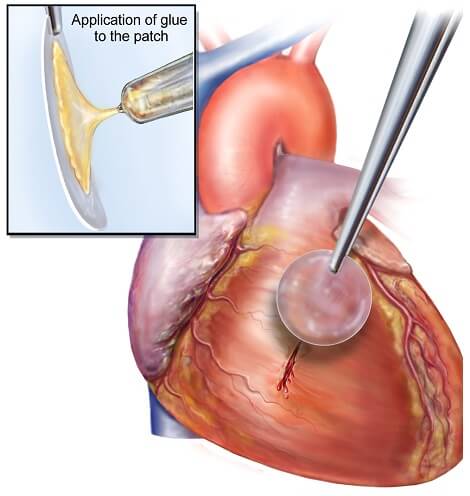In a pre-clinical study, scientists from three research institutes in the US (Boston Children's Hospital, Brigham and Women's Hospital and Massachusetts Institute of Technology, MIT) developed a glue inspired by nature that is able to quickly stick biodegradable patches inside a beating heart - exactly where they form Holes in the heart, in cases of heart defects in the chambers of the heart.

When a child is born with a heart defect, such as a hole in the heart, the invasive healing methods are particularly challenging due to the inability to secure the medical devices quickly and safely within the heart area. The solution of using sutures takes too long and may cause damage to delicate cardiac tissues, and the adhesives available clinically today are either too expensive or tend to lose their activity in the presence of blood or under dynamic conditions, such as a beating heart.
"Approximately 400 babies are born every year in the US with congenital heart defects, and those who require medical treatment are required for several surgeries in order to replace the non-degradable implants that do not grow like the growing patients," said Dr. Jeffrey Karp from the Department of Biomedical Engineering at the institution The Brigham and Women's (BWH) study in Boston, USA.
In a pre-clinical study, scientists from three research institutes in the US (Boston Children's Hospital, Brigham and Women's Hospital and Massachusetts Institute of Technology, MIT) developed a glue inspired by nature that is able to quickly stick biodegradable patches inside a beating heart - exactly where they form Holes in the heart, in cases of heart defects in the chambers of the heart.
Recognizing the fact that in nature there are many creatures that are able to secrete viscous liquids that can repel water, adhesives that allow them to stick to surfaces even in wet and dynamic conditions, the researchers developed materials inspired by these liquids that were also biodegradable, elastic and adapted to the human body. According to the researchers, the biodegradable patches that were connected with the glue remained connected even with increased heart rates and blood pressures.
"This adhesion system overcomes all the shortcomings of the previous systems by working properly in the presence of blood and moving structures," said one of the research partners. "Our system should provide doctors with a completely new and simpler technology for tissue restoration in order to improve the quality of life of patients who have undergone surgical procedures."
"This study proved that the glue was strong enough to connect the tissue and the patches on top of the heart with a quality equal to sutures," notes one of the researchers. "In addition, the glue is biodegradable and adapted to the living body, so that no foreign bone or toxic substance remains in the body in those operated on." Moreover, the adhesive applications are activated with the help of ultraviolet radiation, which enables a non-bleeding and highly conformable sealing point within five seconds of irradiation, this is to seal large blood vessels subject to high pressure and defects in the walls of the heart.
The researchers note that the water-repellent glue activated with the help of their radiation will be useful in reducing the invasiveness of surgical procedures, shortening the operation times and improving the results of the operations. "We are pleased to see that the materials we developed are also used in broader applications designed to improve human life," says one of the researchers. The new adhesive was developed within the framework of the start-up company (Gecko Biomedical) located in Paris. The company raised 8 million euros during the first fundraising round and the adhesive is expected to reach the market within two to three years.

4 תגובות
Indeed, the great innovation is an effective adhesive in a dynamic organ whose glued surfaces expand and contract. The other tears are tears in a static surface that does not move.
There are already such adhesives
Is it possible that the news value is the application in the heart?
It's interesting that they didn't choose to start applying in less dangerous places such as torn muscles?
Excellent!
In my opinion, you can and should try to fix other things with the help of this glue, such as:
Aortic aneurysm.
Tears in the abdominal membrane (hernia, hernia).
Ruptures in the nerves.
Cartilage tears.
torn ligaments.
Rib fractures.
injuries.